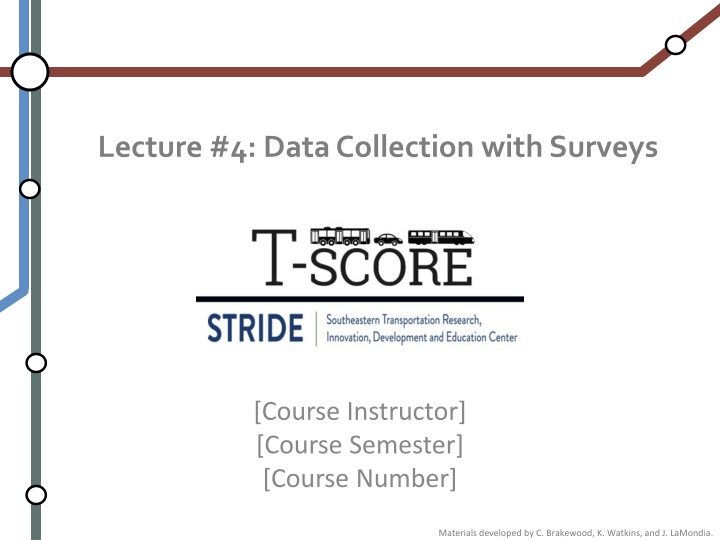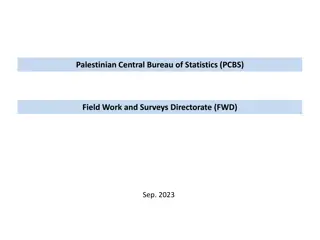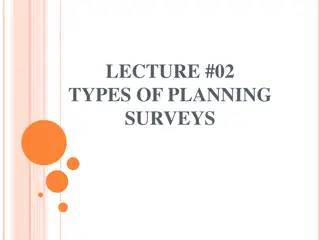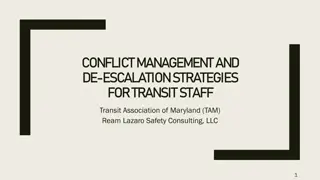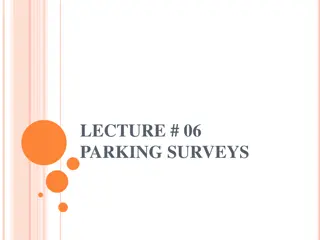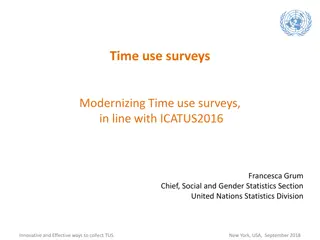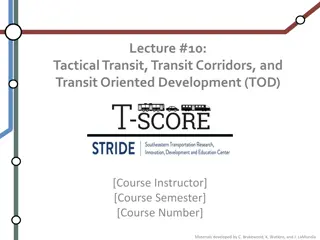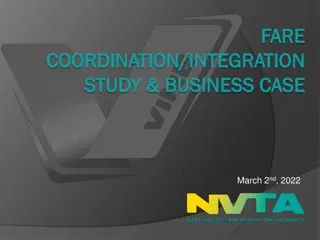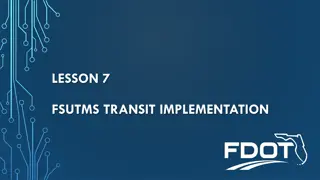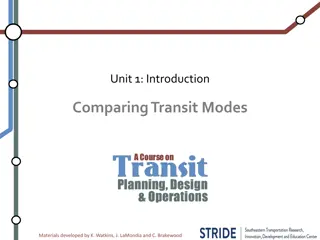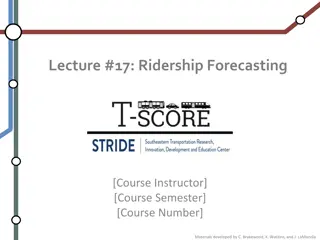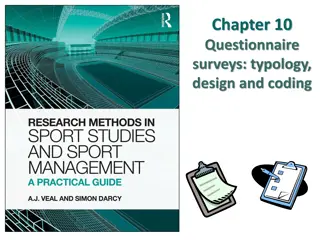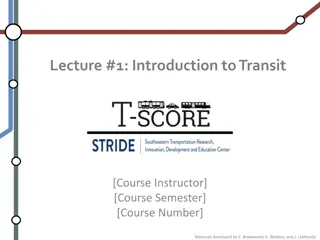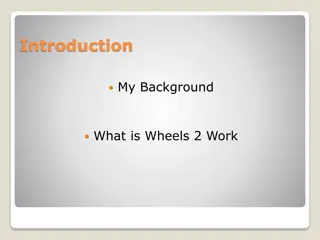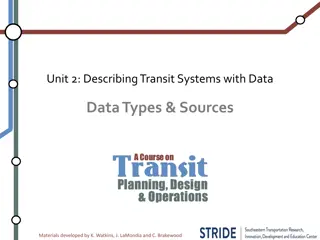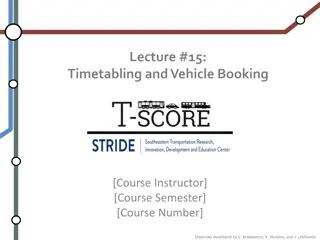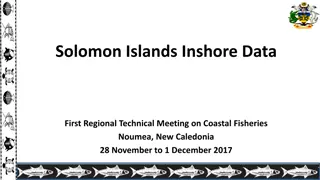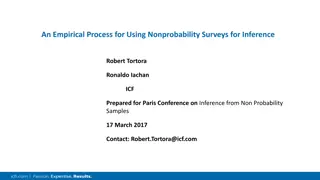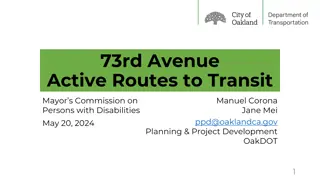Data Collection Methods in Surveys for Transit Rider Feedback
Explore the various types of surveys, methods of sampling, survey content, and instruments used in data collection for transit rider surveys. Learn about longitudinal and cross-sectional surveys, along with different survey methods such as self-administered written questionnaires, personal interviews, and tablet surveys. Understand the strengths and weaknesses of each method to implement effective data collection strategies for transit authorities.
Download Presentation

Please find below an Image/Link to download the presentation.
The content on the website is provided AS IS for your information and personal use only. It may not be sold, licensed, or shared on other websites without obtaining consent from the author.If you encounter any issues during the download, it is possible that the publisher has removed the file from their server.
You are allowed to download the files provided on this website for personal or commercial use, subject to the condition that they are used lawfully. All files are the property of their respective owners.
The content on the website is provided AS IS for your information and personal use only. It may not be sold, licensed, or shared on other websites without obtaining consent from the author.
E N D
Presentation Transcript
Lecture #4: Data Collection with Surveys [Course Instructor] [Course Semester] [Course Number] Materials developed by C. Brakewood, K. Watkins, and J. LaMondia.
Outline: Surveys Types of surveys. Methods of sampling. Survey content. Survey instruments. In-class exercise. Data collection plan. Example: Chicago Transit Authority Survey.
Types of Surveys Longitudinal survey Over time Cross-sectional survey Single point in time
Survey Methods Goal: Transit rider survey How: Intercept onboard vehicle or at stop/station Methods: 1. Self-administered written questionnaire 2. Personal interview and written questionnaire 3. Personal interview and handheld tablets 4. Two-Step Methods a. First: Recruit onboard or in-stations b. Second: Online or Computer-Aided Telephone Interview (CATI) Source: TCRP Synthesis 138; pages 10-11
Method 1: Self-administered paper surveys Strengths Weaknesses Source: TCRP Synthesis 138; page 13
Example: Self-administered paper survey Source: Candace Brakewood & MTA
Method 2: Interview-administered paper surveys Strengths Can be conducted alongside self-administered surveys to accommodate persons with certain disabilities, limited English proficiency, or limited literacy Weaknesses Does not benefit from the automation available in the tablet surveys Source: TCRP Synthesis 138; page 13
Method 3: Interview-administered tablet surveys Strengths Better data quality Ability to incorporate auto validation and skip logic into survey instrument Allows for tracking of responses in real time; can identify systematic biases or sampling issues more easily Streamlined data entry and data cleaning Interview approach can more flexibly accommodate users with low literacy or limited English-speaking ability Weaknesses May result in high costs due to increase in staff house to administer survey Some users may be uncomfortable sharing personal details in an interview setting Challenging to conduct in a crowded setting or place where user has limited time to participate in an interview Source: TCRP Synthesis 138; page 13
Method 4: Two-step Surveys Strengths Weaknesses Source: TCRP Synthesis 138; page 13
Survey Approaches Used in Practice Paper surveys are still the most common approach. Source: TCRP Synthesis 138; page 28
We cant survey every single transit rider, so we select some to survey using METHODS OF SAMPLING
Methods of Sampling Methods: 1. Simple Random Sampling 2. Systematic Sampling every nth unit selected 3. Stratified Sampling divide the population into groups (strata); take a sample within each group 4. Others Source: TCRP Synthesis 138; pages 18-19
Sample Size Determination Depends on the population size (e.g., number of riders) and the level of precision desired Increase sample size increase costs Example for Simple Random Sampling Source: TCRP Synthesis 63; page 16
What is commonly included in transit surveys? SURVEY CONTENT
Research Goals & Content Origin & Destination Surveys This trip : Origin, destination, purpose, access mode, egress mode, etc. General Travel Behavior Frequency of travel, how long using transit, alternative modes Demographics Gender, age, race, driver s license, HH income, HH size, employment status Satisfaction Attributes of service: timely service, speed of service, cleanliness, comfort, safety, crowing, information Other Fare payment, new technologies, communications, etc.
Survey Content Used in Practice Source: TCRP Synthesis 138; page 30
Translating Research into Survey Questions TCRP Synthesis 63; page 19
How to write a good survey SURVEY INSTRUMENT
Types of Questions Closed-Ended Dichotomous (2 answers, e.g. Yes/No) Nominal (Categorical) Ordinal (a.k.a. Likert, Ranking) Filter/Contingency (Qualified) Partially-Closed Last answer is Other______ Open-Ended
Dos and Donts Questions should be: Concise (multiple choice) Understandable Useful M.E.C.E. = Mutually Exclusive & Collectively Exhaustive Questions should NOT be: Double-barreled Double negative Technical jargon Long-winded Redundant Obtrusive or embarrassing
Now, its time for you to practice IN-CLASS EXERCISE
In-Class Exercise 1. How satisfied are you with the safety and cleanliness of CARTA buses? Very Satisfied Somewhat Satisfied Neutral Somewhat Dissatisfied Very Dissatisfied What is the primary flaw with question 1? How would you improve this question? 2. How useful do you find the information from CARTA s Automated Vehicle Location system? Very Useful Somewhat Useful Not Useful N/A What are some of the flaws with question 2?How would you improve this question? 3. Do you agree or disagree with the following statement? CARTA should not increase the frequency of bus service. I agree I disagree What is the primary flaw with question 3? How would you improve this question? 4. Please indicate which of the following categories best describes your total household income? $20,000 or less $20,000 to $40,000 $40,000 to $60,000 $60,000 to $80,000 $80,000 to $100,000 $100,000 or more What is the primary flaw with question 4? How would you improve this question?
Putting it all together in order to create a DATA COLLECTION PLAN
Creating a Data Collection Plan 1. Determine research goals 2. Select survey mode & sampling methodology 3. Determine necessary sample size 4. Create detailed sampling plan 5. Draft questionnaire 6. Pre-test the questionnaire 7. Conduct staff training 8. Distribute survey & revise sampling plan 9. Code/process data & error check
Other Considerations Longitudinal comparisons Consistency of questions with prior transit surveys Underrepresented groups Language (non-English speakers) Those who cannot read/write Others TCRP Synthesis 138 page 36
What does a (good) transit survey look like? CHICAGO TRANSIT AUTHORITY
2016 Chicago Transit Authority Customer Satisfaction Survey Objective: Comprehensive review of customer satisfaction conducted every two to three years Content Included: General travel behavior (modes, access/egress, etc.) Fare payment types and media Technology use (e.g., smartphones, email) Demographics Satisfaction (35 questions across 9 dimensions) Comfort while riding; appearance; access to service; overall service; service delivery; information; communications on buses and trains; employee performance; personal safety Source: https://www.rtachicago.org/sites/default/files/documents/plansandprograms/Regional- Transportation-Authority_-2016-Customer-Satisfaction-Study.pdf and http://www.transitchicago.com/assets/1/surveys/cssurvey2003.pdf
CTA: Mode & Sampling Method Onboard paper survey (distributed ~9,900 paper surveys) Email recruitment for online survey (~60,000 email invitations) Stratified Sampling 24 bus groups or rail lines (branch) Sample Size Minimum of 270 respondents per strata Onboard paper survey responses: 949 (10% response rate) Online survey responses: 7,959 (13% response rate) Source: 2016 CTA Survey; page 35 and http://www.transitchicago.com/assets/1/surveys/cssurvey2003.pdf
CTA Online Questionnaire 2016 CTA Survey; page 33
CTA: Results 2016 CTA Survey; page 52
Conclusion Surveys are a good way for agencies to know who their riders are and what they want. There are several survey types with varying costs, penetration and bias. They should be chosen to match their target. Surveys should be easy to understand and should encourage participants to complete them.
Reference Materials in this lecture were taken from: TCRP Synthesis 63: On-board and Intercept Transit Survey Techniques TCRP Synthesis 138: Public Transit Rider Origin-Destination Survey Methods and Technologies CTA, Customer Satisfaction Survey, 2016.
